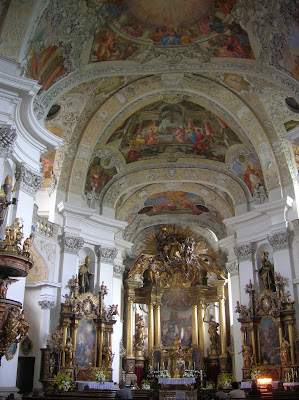Banz has a commanding position across the valley opposite Vierzehnheiligen. I have visited both when in this area in 1989 and 1994. This Benedictine foundation dates back to around 1070. After the Thirty Years' War the abbey had to be re-built. The abbots Eucharius Weiner and Kilian During commissioned Johann Leonhard Dientzenhofer and after his death in 1707, his brother Johann Dientzenhofer. Construction began in 1698. The church was consecrated in 1719. The interior is built, with a series of ellipses. The main altar, the chancel and the statues of saints in the church and on the facade are by Balthasar Esterbauer; the ceiling frescoes are by Melchior Steidl. The choir stalls were made by the court cabinet maker and ebonist of Schönborn, Johann Georg Nesstfell. In both visits I have not got beyond the main door, giving tantalising views of the interior. I look forward to going inside next time.
In the second half of the 18th century Banz Abbey was known throughout the Holy Roman Empire as a place of Catholic enlightenment and for the scholarship of its monks. Unfortunately this did not save it from secularisation and dissolution in 1803.
Since 1978 the former monastery has been in the possession of the Hanns Seidel Foundation.

Gregor Kollmorgen has written a very good tour of the church with photos here.
Now we
come to the fun part of this post. I am trying to bring these wonderful
buildings back to life by finding matching music. I had slim hope of succeeding
with Banz. I was so wrong because I have found a gem : Johann Valentin
Rathgeber. 1682-1750. A discovery like this makes this blog worth the effort!
Rathgeber was born in Oberelsbach. His father, an organist, gave him his first
music lessons. At the beginning of the 18th century, he began studying at the
University of Würzburg, initially studying rhetoric, mathematics and law; later
he changed direction and continued his studies in theology.
His
first position was as a teacher at the Julius Hospital in Würzburg. In 1707 he
took up the post of chamber musician and servant of the abbot of the Banz
Abbey, Kilian Düring. A short time later he joined the Benedictine Order, and
in 1711 entered the priesthood. Thereafter, he was organist, choirmaster and
preacher at the abbey. Between 1729 and 1738 he went on a study trip. It is an
open question whether he did that with permission from his abbot or not.
Documented stops on this trip were Mainz, Bonn, Cologne, Trier, Stuttgart,
Regensburg, Germany, Switzerland, Vienna and Styria. Compositions from this
period were primarily dedicated to his respective hosts. In 1738 he returned to
the abbey, where he then lived in seclusion for a while. A short time later, he
was allowed to regain his former office. He lived in Banz Abbey until his death there, at the age
of 68, which was attributed to gout.
Here are some examples of his output.
Missa Sanctorum Apostolorum 1738
10 Pastorales for Christmas time 1743.Delightful Christmas music!
Chelys sonora, Op 6 - Concerto No.21 in C-major : jolly stuff!

No comments:
Post a Comment